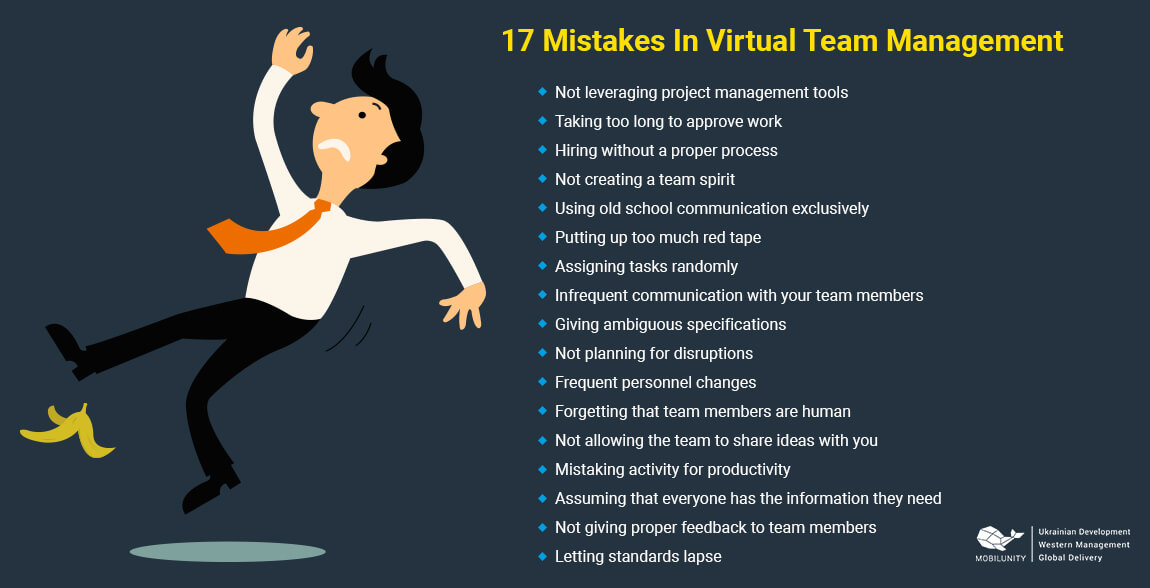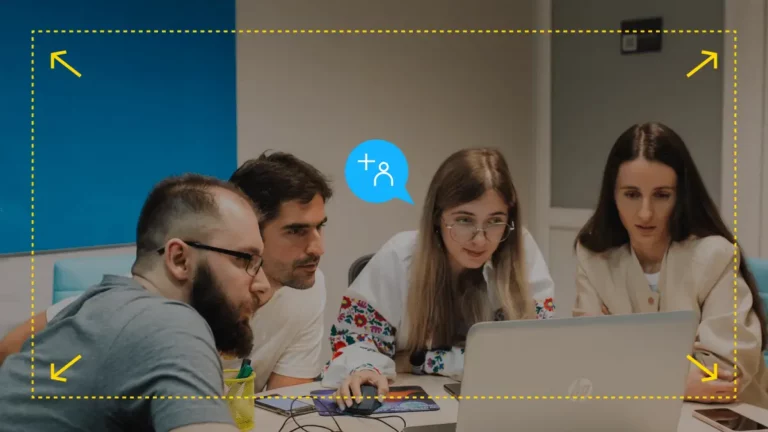17 Worst Mistakes in Managing Virtual Teams
- What Is a Virtual Team?
- Virtual Team vs Remote Team: Isn’t It the Same?
- Virtual Team Advantages and Disadvantages
- How Virtual Teams Help Improve Business Processes?
- 17 Major Mistakes in Managing a Virtual Team
- How to Manage a Virtual Team Effectively?
- How Virtual Team Management Is Easy Nowadays?
- Why Choose Mobilunity for Virtual Development Team?
Virtual development teams have become a new standard of the software development ecosystem. According to the Forbes report, more than 50% of the US-based population work remotely one way or the other. Almost all companies adopt virtual team development model for their custom software development services needs in 2019. Owing to the supportive legislation, price competitiveness, and the emergence of powerful technologies like blockchain and others will lead to a substantial growth of virtual teams worldwide.
What Is a Virtual Team?
The virtual team definition is evolving continuously with the emergence of newer technologies and services (e.g. nearshoring, offshoring services, etc.) in the marketplace. According to Alchemy of Manager, the specific definition virtual team is a small number of people from cross-functional responsibilities and work remotely for a specific task. There is very little difference between remote and virtual team definitions. The remote teams are normally under the manager of one line or discipline of work, while the virtual team may be under different line managers, but the goal may be common to accomplish.
What is virtual team? We can also define in other words that a small number of people located at different geographical locations, working under managers not co-located under a common roof is known as the virtual team. All those people from different areas of expertise join together for a specific project or task to accomplish within the stipulated time frame.
Virtual Team vs Remote Team: Isn’t It the Same?
The notions of ‘virtual’ and ‘remote’ team seem to be interchangeable. The main feature to distinguish it is a way of management:
- Remote team. It is connected to one manager, delivers defined work. The team members are not co-located. The team members may have a wide range of skills or have one particular specialization.
- Virtual team. It is created to complete some specific tasks and includes specialists from different fields. These people have different functional managers. Some parts of the virtual team may be co-located. If the virtual team has been created for a definite project, it is disbanded, as soon as the project is done.
Remote team vs virtual team – the main difference is in the variety of team types:
- The project team is created for the specific project, it exists during the determined period of time– until the project is completed.
- The standing team works together on a regular basis and usually has regular meetings.
- The parallel team consists of the highly-skilled specialists, who come together to give some recommendations.
- The project development team is a decision-maker. The members may be added or discarded during the work. The team is created to work on new products.
Virtual Team Advantages and Disadvantages
Let’s talk about Virtual team advantages and disadvantages from different aspects of our present-day software development ecosystems. More than 53.3% of the software developers wanted to work remotely rather than in office in 2017. Meanwhile, the Markets Insider, a research company predicted that more than 50% of the US population will be remote workers by 2020.
All these statistics indicate that there are numerous advantages of having a virtual team for managing the business environment in the present marketplace.
Advantages
The main advantage of a virtual team is the substantial reduction in software development cost from the software industry perspective. The other advantages include:
- reduced cost for office space
- reduced energy and equipment cost
- access to a wide range of technical talent across the globe
- availability of talent at reduced prices in countries where salaries are lower
- better employer loyalty and retention rates
- no traveling required
- use of different time zones speeds up the project timeline due to 24×7 work hours
- faster project delivery
- higher project success rates
- reduced unnecessary meetings
- faster company transformation digitally
- higher productivity
- flexibility in scaling up and down the team sizes
- faster hiring process
- reduced hiring process cost
- higher performance
- and many more
Disadvantages
There many challenges of the virtual team that the employers face. Those virtual team challenges can sometimes become disadvantages for the employer as well as for the employees. A few major disadvantages are listed below.
- communication gap is one of the major disadvantages of virtual teams
- lake of team bonding and cohesiveness
- technical problems can disrupt the smooth working from remote locations
- problems in virtual team management owing to a geographically dispersed team
- how to manage a virtual team is a unique field of management that is a bit more complex
- cross-culture and language barriers
- misinterpretation of communication is also a big disadvantage
The discussion of virtual team advantages and disadvantages clearly indicates that the advantages are much better than those disadvantages, which can also be covered easily. That’s why many industries choose virtual development teams for their software projects.

How Virtual Teams Help Improve Business Processes?
Modern business processes are extensively dependent on the technologies, which can be accessed and implemented from anywhere in the world with the help of ICT. There are many virtual team examples that are handling business processing from a remote location and even improving them significantly. Before hiring a CTO, you can research some of the best questions to ask to determine if you will rent a CTO that matches your requirements.
According to the latest statistics, more than 66% of the multinational companies use virtual teams for managing their projects, business processes, and services in Europe. The major business processes that use remote teams extensively include:
- customer/technical support
- telephone marketing
- digital marketing
- search engine optimization
- software application development
- operations and maintaining of software-based services
- human resource (HR) hiring
- managing a virtual team itself
- project planning
- project monitoring
- project implementation
- performance monitoring of software-based services
- and much more
By using the power of virtual teams, enterprises can not only manage all of the above business processes but also can improve them significantly by utilizing the latest technologies of managing a virtual team remotely.
A substantial improvement in performance and productivity has been observed in the software development process by managing a virtual team effectively. Many research studies suggest that virtual teams make significant improvements in customer support, project management, customer relationships, and resource management.
There are many examples of multinational companies that are managing a virtual team at least; a few of them are listed below:
- International Business Machine (IBM)
- General Motors
- Hewlett Packard
- Hasbro Inc
- Kingston Technologies
- Boeing Corporation
- Jabil International
- And others
17 Major Mistakes in Managing a Virtual Team
Managing a virtual team is a complex job owing to the diverse geographical location, cross-culture, cross-language, and work practices. The lack of interactivity and boredom are top factors that can lead to a dip in the performance of the virtual team and consequently a boredom dip is observed, according to the latest studies.
The team starts dispersing mentally and the focus of the work is lost. This situation normally leads to very disastrous outcomes. These conditions in the virtual teams develop due to the following major mistakes made by the management in managing a virtual team effectively.
- Not leveraging project management tools – Working with a virtual team is different from working in the same office because management and workers can be in different time zones. This means that you need to take extra steps to keep the project on schedule. Digital project management tools such as BaseCamp and Trello are great for this task. Even if you have a small project, failing to use a project management tool can make your team less efficient.
- Taking too long to approve work – Your remote team may not be in the office with you, but they need timely work approvals. If you get back to them faster, the work will move faster as well. Managing software developers team leaders expect to improve time to market and get the product faster. But in fact, the speed and the quality of work highly depend on the frequency and quality of the communication. Try flow efficiency metrics to find out, how much time your team spends waiting for an answer of approval.
- Hiring without a proper process – Since you might never meet your remote team in person, you need to exercise greater care when hiring. Carefully assess the capabilities the team will be able to put to work for your project. Мake sure the team members have relevant skills and experience. If you are not sure about the technologies you are going to use and the scope of work you are going to help – find a team with the leader, who knows how to manage software developers. The qualified team leader will decide on the technology stack for the product, find the proper coders and develop a plan of work.
- Not creating a team spirit – The best project managers create a cohesive unit that acts as one. When managing virtual teams, take special heed to create a team spirit that allows your team to give their all to the work. Let the remote team take part in the brainstorms and propose some ideas. Managing a software development team respect virtual professionals. You are hiring them not only because of the financial profit but also because they are skilled coders, right? The respect to the virtual developers helps to create a team spirit and improve quality: employees will be happy to know, that their work is important for the whole project.
- Using old school communication exclusively – In this modern age, using phone calls and emails may work, but global project management requires the sophistication of modern tools. Invest in online collaboration technology like Slack and Gitter to manage team communications. Out of date communication technologies also may fail – imagine the important email, which lends in the spam folder by mistake. The other downside of such means id the risk of the data breach. And in case of work with the remote virtual teams, data security is extremely important. So, if you are deciding how to manage software development team, pay attention to the modern comfortable and secure means, which help to communicate effectively and have all the documents safe in one place.
- Putting up too much red tape – At the end of the day, your team just wants to get the work done. It’s easy to set up too much remote team management red tape around things like code access, or getting approval for design choices. Where possible, eliminate friction so work can get done. Negative feedback is also dangerous for team spirit and motivation. So try to be very polite and express yourself correctly, in order not to provoke conflicts.
- Assigning tasks randomly – It is tempting to treat your remote team workers as interchangeable cogs. This is also a way to get inconsistent results with your IT outsourcing. Assign each task to the team member most suited for it. The simplest way to cope with the tasks is developing a plan. Stick to it, managing a team of software developers. It will help you and the team members to stay tuned to the workflow. The whole team should understand where they are, on which stage is the project, and what should they do next. It makes workflow more efficient and communication easier.
- Infrequent communication with your team members – Communication is essential, especially when remote work is involved. If you are the sort of manager who goes for an entire week or more without communicating, you may be in for a surprise. Work might not be getting done, and you would never know until it is too late. Regular communication between you and your team keeps everyone in sync. Handling the communication it is important to remember about the time difference. The managed software developers team would probably be located several time zones away from you. Try to organize the schedule in a way everyone will have a comfortable time for communication. Plan the written and visual communication, organize some periodic common meetings.
- Giving ambiguous specifications – Give your outsourcing services provider clear targets so they know what to aim for. Having coding requirements that are too vague will demoralize the team and lead to slow progress. The communication with the virtual team is more complicated, so you may face some misunderstanding in the vision and mission of the project. To avoid these troubles, set the measurable goals, divide big parts of work into the smaller steps and fix everything in the documents. You can even make the check-lists to control the steps completely.
- Not planning for disruptions – A good remote project manager knows that disruptions may occur. As such, you need to plan in some buffer time into your schedule so that disruptions don’t make you miss deadlines. Managing remote software developers never underestimate communication. It is the easiest way to get to know about some troubles on the way. Check often, if everything is ok. If you will find the disruption early, you will be able to handle it without harming the project.
- Frequent personnel changes – For a complex software project to progress smoothly, you need to minimize personnel changes and reassignments. New team members will require extra time before they can be as efficient as the ones they replace. If you need to reinforce the team, it is better to provide training. Many developers consider project training as work perks. Improving the quality of the team you get several benefits at once: the team members get the needed skills, they become involved in your specific business, the remote programmers turn into the close-knit team. You will enjoy working with such a crew.
- Forgetting that team members are human – It is easy sometimes to forget that team members are human. A bad day, problems in their personal life and other things can make them underperform. A good manager finds ways to get to the root of the problem and help team members solve problems. Want to know how to manage remote team effectively? Respect personal space. Don’t expect the team members will work and answer your questions 24\7, late at night, on weekends, and holidays. Keep that in mind, developing the working schedule. And pay attention to the religious or national holidays of the developers – they may influence their plan as well.
- Not allowing the team to share ideas with you – Good managers know that communication is a two-way street. Sometimes, having tasks written down in a project management platform has the perverse effect of closing you off to new ideas from your team. Be flexible enough, when managing remote teams, to encourage the team to bring up ideas for your consideration. As professionals, developers may have a different point of view, some suggestions, and ideas. It could be a good idea to change the initial vision of the product to make it better.
- Mistaking activity for productivity – Managing a team remotely means you need to become an astute observer. There is a vast difference between the hours billed and tasks accomplished. Ensure that your dispersed teams are getting the most results accomplished for the hours they are billing. If you are trying to measure productivity, measure it by the completed tasks, but not by the time spent. For example, the testing process may take more time than you’ve expected. And after the testing, you may need extra debugging. These processes take a lot of time, but they help to create a functional application or website.
- Assuming that everyone has the information they need – In software projects, in particular, there is a wide variety of implementations that can be taken to address a technical problem. Unless you as the manager have made it very clear how things are to be done, work may not be done to specifications. This can be a very costly mistake. The code may have to be rewritten, entire weeks of work scrapped. Make sure, therefore, that everyone on the team has the information they need to get their work done properly.
- Not giving proper feedback to team members – When managing a remote project, feedback becomes much more important. Since your team is not in the office with you, they cannot tell how you feel about the progress they are making other than what you let on in electronic communications. As a project manager, you need to create a system in which you give accurate feedback to team members. If something is wrong, they will be able to use your feedback in order to fix it.
- Letting standards lapse – When working remotely, you have less chance to influence culture than when working in the same office as the entire team. It is your responsibility as the manager to keep standards high and drive the team towards ambitious goals. How to manage remote teams effectively? Keep the team members motivated, value their work, pay well. Highly motivated employees are more likely to keep the standards high – it works with the virtual teams as well as with the real ones.
How to Manage a Virtual Team Effectively?
It has been found in the latest research that more than 70% of the people believe that virtual teams are increasingly prevalent in the very near future. The technology is the most powerful driver (47%) of the future of the virtual teams because it helps the management to effectively manage the virtual teams.
However, any kind of cooperation can be successful only if managed right. Without coordination, it is impossible to reach goals, even if you have the best team ever. In the case of the virtual team, management has more special features. It differs from the methods for the in-house teams and requires special approaches.The effective management of a virtual team can be achieved by implementing the following factors correctly.
#1 Establish Clear and Transparent Communication
Communication is the most fundamental tool that helps you manage your virtual team effectively. It is highly recommended to use multiple modes of communication such as video conferencing, voice calls, video calls, text, and email. The complex matters should be discussed through video conferencing so that you can understand the body language of the participants easily.
#2 Set Project Goals Clearly
The goals and direction of work should be clearly defined. Every employee should be very much clear about the objectives of the project so that the focus of the team does not digress from the desired goals.
#3 Choose the Right Team
This is another very critical factor. If you choose the team with the right skills and attitude, your team will be easy to manage. The right team will respond rightly to the queries that you and your customers have. Thus, you will be able to benefit from your team more efficiently.
#4 Use Latest Management Tools
Choose the best project management, communication management, performance tracking, and employee collaboration software tools. You can also choose the comprehensive virtual team management software tools that offer all team management components required for effective management of a virtual team.
5 Create a Professional Work Environment
A dynamic team works perfectly in a professional work environment where every team member is valued as per his/her worth and rewarded with their achievements. There should be a fully transparent and motivational environment so that the people own their team and enjoy contributing to the team objectives. A cohesive and mutual trust-based environment makes your virtual team more productive.
How Virtual Team Management Is Easy Nowadays?
The management of virtual teams has become much easier nowadays due to the innovative use of technology, which includes:
- comprehensive communication platforms
- professional-grade collaboration and file-sharing systems
- time trackers and auto-payment systems
- faster internet speed
- automated software testing and performance monitoring systems
- availability of 24×7 work overlaps
- employee performance assessment tools
- availability of numerous mobile apps that can help you improve virtual team management
- effective use of 3D technology in technical communication
- efficient use of modern project management and development methodologies
- mature industry best practices and standard rules developed by the standard organizations
- easier business laws to work in a global work environment
- a better understanding of the multiple cultures and languages
Why Choose Mobilunity for Virtual Development Team?
Mobilunity is one of the most professional companies that offer a dedicated development team for hire and effective management of the remote teams. The company is located at the most ideal geographical location, which is at a very short traveling distance from almost all parts of the world.
Mobilunity virtual team management service offers you the benefits mentioned below:
- highly professional-grade virtual team
- highly skilled and experienced software developers and testers
- dedicated teams to work fully on your project
- very affordable and fixed prices without any hidden charges at all
- full control over the virtual team powered by the highly experienced management team
- world-class work environment and powerful tools
- offer fully customized solutions that suit 100% with your business needs
- on-time project delivery with a 100% project success rate
Build your virtual development team with Mobilunity!
Disclaimer: All salaries and prices mentioned within the article are approximate numbers based on the research done by our in-house Marketing Research Team. Please use these numbers as a reference for comparison only. Feel free to use the contact form to inquire on the specific cost of the talent according to your vacancy requirements and chosen model of engagement.














